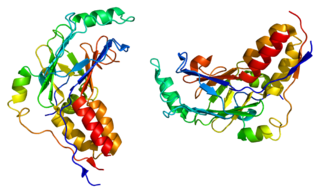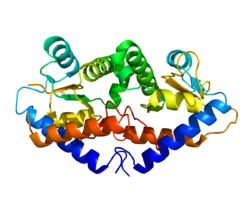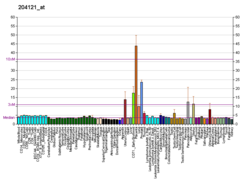
p53, also known as Tumor protein P53, cellular tumor antigen p53, or transformation-related protein 53 (TRP53) is a regulatory protein that is often mutated in human cancers. The p53 proteins are crucial in vertebrates, where they prevent cancer formation. As such, p53 has been described as "the guardian of the genome" because of its role in conserving stability by preventing genome mutation. Hence TP53 is classified as a tumor suppressor gene.

p21Cip1, also known as cyclin-dependent kinase inhibitor 1 or CDK-interacting protein 1, is a cyclin-dependent kinase inhibitor (CKI) that is capable of inhibiting all cyclin/CDK complexes, though is primarily associated with inhibition of CDK2. p21 represents a major target of p53 activity and thus is associated with linking DNA damage to cell cycle arrest. This protein is encoded by the CDKN1A gene located on chromosome 6 (6p21.2) in humans.

Mothers against decapentaplegic homolog 3 also known as SMAD family member 3 or SMAD3 is a protein that in humans is encoded by the SMAD3 gene.
The Growth Arrest and DNA Damage or gadd45 genes, including GADD45A GADD45B, and GADD45G, are implicated as stress sensors that modulate the response of mammalian cells to genotoxic/physiological stress, and modulate tumor formation. Gadd45 proteins interact with other proteins implicated in stress responses, including PCNA, p21, Cdc2/CyclinB1, MEKK4, and p38 kinase.

Ras association domain-containing protein 1 is a protein that in humans is encoded by the RASSF1 gene.

MAP kinase-activated protein kinase 2 is an enzyme that in humans is encoded by the MAPKAPK2 gene.

Death-associated protein kinase 1 is an enzyme that in humans is encoded by the DAPK1 gene.

Proliferation-associated protein 2G4 (PA2G4) also known as ErbB3-binding protein 1 (EBP1) is a protein that in humans is encoded by the PA2G4 gene.

DNA damage-inducible transcript 3, also known as C/EBP homologous protein (CHOP), is a pro-apoptotic transcription factor that is encoded by the DDIT3 gene. It is a member of the CCAAT/enhancer-binding protein (C/EBP) family of DNA-binding transcription factors. The protein functions as a dominant-negative inhibitor by forming heterodimers with other C/EBP members, preventing their DNA binding activity. The protein is implicated in adipogenesis and erythropoiesis and has an important role in the cell's stress response.

Growth arrest and DNA-damage-inducible protein GADD45 alpha is a protein that in humans is encoded by the GADD45A gene.

Protein NDRG1 is a protein that in humans is encoded by the NDRG1 gene.

Ribosomal protein S6 kinase alpha-5 is an enzyme that in humans is encoded by the RPS6KA5 gene. This kinase, together with RPS6KA4, are thought to mediate the phosphorylation of histone H3, linked to the expression of immediate early genes.

Nuclear factor of activated T-cells 5, also known as NFAT5 and sometimes TonEBP, is a human gene that encodes a transcription factor that regulates the expression of genes involved in the osmotic stress.

Growth arrest and DNA-damage-inducible, beta, also known as GADD45B, is a protein which in humans is encoded by the GADD45B gene.

Metastasis-associated protein MTA2 is a protein that in humans is encoded by the MTA2 gene.

Autophagy related 5 (ATG5) is a protein that, in humans, is encoded by the ATG5 gene located on Chromosome 6. It is an E3 ubi autophagic cell death. ATG5 is a key protein involved in the extension of the phagophoric membrane in autophagic vesicles. It is activated by ATG7 and forms a complex with ATG12 and ATG16L1. This complex is necessary for LC3-I conjugation to PE (phosphatidylethanolamine) to form LC3-II. ATG5 can also act as a pro-apoptotic molecule targeted to the mitochondria. Under low levels of DNA damage, ATG5 can translocate to the nucleus and interact with survivin.

Mitogen-activated protein kinase kinase kinase 4 is an enzyme that in humans is encoded by the MAP3K4 gene.

Growth arrest and DNA-damage-inducible proteins-interacting protein 1 is a protein that in humans is encoded by the GADD45GIP1 gene.

Mitogen-activated protein kinase 13, also known as stress-activated protein kinase 4 (SAPK4), is an enzyme that in humans is encoded by the MAPK13 gene.
Epigenetic regulation of neurogenesis is the role that epigenetics plays in the regulation of neurogenesis.



















